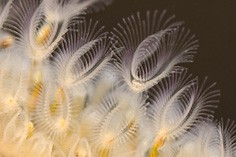Invertebrate
Zoology Bryozoans
Bryozoans (sometimes referred to as ectoprocts) are sessile colonial lophophorates that superficially resemble clumps of moss (bryophyte means "moss"). All are aquatic, mostly marine. Colonies of different species have different growth patterns—some create furry colonies, while others grow into jelly-like masses, fans, bushes or sheets.
Bryozoans are suspension feeders that are classified based on the presence a retractable lophophore, a crown of ciliated tentacles around their mouth. A lophophore is a specialized feeding structure used to capture small food particles. Approximately 5,000 living species exist; however, there are several times that number of fossils.
Bryozoans are widely distributed across the globe with a notably high diversity in the Southern Ocean. Seagrasses as well as floating seaweed, mangrove roots, shells, docks, pilings and other structures provide support for bryozoan colonies. In turn, bryozoans provide habitat for many species of juvenile fishes and their invertebrate prey such as polychaete worms, amphipods and copepods.
Bryozoans are ecologically important because, as suspension feeders, they act as living filters in the marine environment.
 |
Phylum
Bryozoa
1. Sessile in marine and freshwater habitats
3. Lophophore circular or horseshoe-shaped
5. Circulatory and excretory structures absent
6.
Colonies produced by asexual budding
|
Some information
taken from Miller,
Return to the Invertebrate Zoology
Homepage.